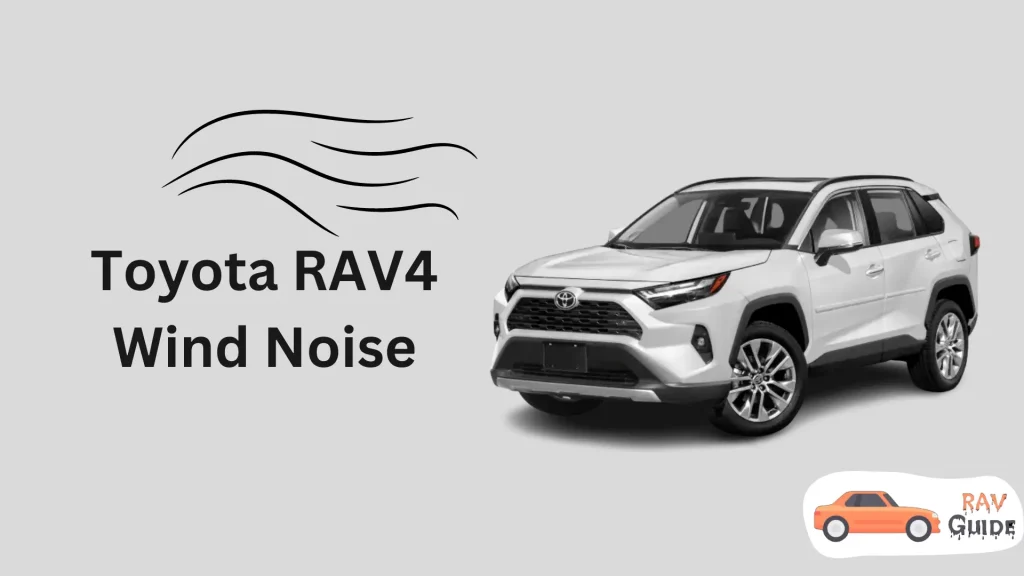The Toyota Rav4 has gained popularity, but some drivers have faced a bothersome problem – wind noise. This noise can be a bit annoying while driving. Let’s explore the reasons behind this wind noise issue in the Toyota Rav4 and look into ways to make your driving experience quieter and more enjoyable.
If you own a Rav4 and have dealt with wind noise or if you’re thinking about getting one, it’s essential to know what causes this noise and how to fix it. By understanding the reasons behind the Toyota RAV4 wind noise and learning practical solutions, you can make better choices to ensure a peaceful ride in your Toyota Rav4.
Now, let’s dive into the details and discover effective ways to tackle the Toyota RAV4 wind noise issue in your vehicle.
Understanding the Wind Noise
Car manufacturers work hard to make cars move smoothly through the air, but some areas still face challenges with wind noise.
Let’s be straightforward – the Toyota RAV4 isn’t a luxury car like a Lexus or BMW. Those fancy cars spend a lot of money to make sure the inside is quiet, but Toyota has to balance quality with affordability. They can’t invest as much in reducing wind noise because they want to keep the cost down for you.
Compared to luxury brands, Toyota has a smaller budget for figuring out how to make the RAV4 quieter when it comes to wind noise. However, they do their best to pass on the savings to you, the consumer.
Now, about that wind noise issue – it’s true that sometimes the RAV4 can be a bit noisy. Personally, when I drive my RAV4 at lower speeds, I hardly notice any wind noise. It’s when I pick up speed, around 50 mph, that I start to hear it. The noise gets even louder when I’m cruising at 70 mph.
Before we get too critical, it’s important to acknowledge that there have been improvements over the years. If you compared a 1999 RAV4 with a current model, you’d definitely notice that things have gotten much better.
Auto Manufacturers Are Aware of Wind Noise
Have you ever wondered how much noise the wind makes when you’re driving? Turns out, it’s a pretty big deal when it comes to picking a car.
Research tells us that people pay a lot of attention to wind noise when deciding which car to buy. J.D. Power and Associates, who do surveys about car quality, found that wind noise is the top complaint from consumers. Why? Well, folks connect a quiet cabin with a high-quality car.
Imagine engineers as real-life superheroes. They spend hours and hours in places called wind tunnels, using fancy computers and microphones. Their mission? To get rid of annoying wind noise in cars.
Thanks to better materials, cool technology, and clever techniques, car-makers can now give us a quieter and smoother ride. Chris Couch, a big shot at Cooper Standard Automotive Inc., says that after the engine, the most significant source of noise inside the car comes from the wind, sneaking in through the windows and glass-run system.
These car companies put in a lot of effort to make driving comfy and smooth. But here’s a fun fact – with all their hard work, sometimes you might still hear tiny noises in your car, even if it’s a fancy one. That’s just the way cars are! You should also know about drive start control malfunction.
How Manufacturers Tackle Wind Noise?
Let’s explore the tricks car manufacturers use to make your ride as quiet as possible.
Now, about the Toyota RAV4. Why does it sometimes make more wind noise? Well, Toyota aimed for fuel efficiency and affordability, not necessarily a luxury-level quiet cabin. Here’s why:
Want to know if the wind noise bothers you in the RAV4? Take it for a spin on the highway during a test drive. That way, you can decide if it meets your quiet ride expectations.
Impact of Wind Noise on Your Driving Experience
Wind noise isn’t just an ordinary annoyance; it can mess with how well your car performs, especially if you’re driving a Toyota Rav4. In this read, we’re going to dig into how wind noise affects your vehicle’s performance, honing in on driver fatigue and distraction, along with the not-so-friendly impact on comfort and ride quality.
Driver Fatigue and Distraction
Picture this – you’re cruising down the road, but instead of enjoying a peaceful drive, there’s this constant whistling or roaring sound in your ears. That’s the doing of wind noise, and it’s more than just a pesky sound. It can distract you big time! This noise pulls your attention away from the road, making accidents more likely. Plus, dealing with this constant noise can tire you out mentally and physically. Imagine trying to focus when there’s a never-ending whooshing in the background – not easy, right?
Reduced Comfort and Ride Quality
Now, let’s talk about the overall feel of your Toyota Rav4. Excessive wind noise doesn’t just mess with your focus; it also messes with your comfort. The cabin, which is supposed to be a peaceful haven, gets invaded by this constant noise, making your driving experience less enjoyable.
And it’s not just you – your passengers feel it too. Imagine trying to have a chat with your friend in the back seat when there’s all this racket going on. Not fun, huh? Long trips or having a car full of people become a lot less pleasant when wind noise is cranking up the volume.
Common Causes of Toyota RAV4 Wind Noise
Let’s pinpoint the spots where wind noise tends to sneak into your car.
Now, let’s dig into why the wind makes a fuss at these spots.
WHY DOORS MAKE NOISE?
When air barges through the door seals, it’s usually because of the weather stripping. Imagine it as the door’s shield against moisture and air. If it’s damaged, air slips through, and the seal is broken. To fix it, inspect your doors, look at the weather stripping, and make sure everything’s snug and in place.
WHAT ABOUT THE ROOF RACK?
Roof racks love catching the wind, sitting atop your car. If they’re not smooth or aerodynamic, they can create a lot of noise. Even the sleek ones, designed to be smooth, might still add a bit of wind chatter.
How to Fix Toyota RAV4 Wind Noise?
If the wind noise through your doors is getting on your nerves, no worries! You can fix it without breaking the bank, and here’s how:
Fixing Door Gap Wind Noise:
Reducing the wind noise from your doors is a breeze with this simple fix. While it might not make it vanish completely, it will surely make a big difference.
Fixing Roof Rack Wind Noise:
If your roof rack is making too much noise, here’s a simple solution:
Get a wind deflector for your roof rack. Wind deflectors are specially designed to cut down on the noise created by airflow through the roof rack. They work like a charm in making things quieter.
So, whether it’s your car doors or the roof rack causing a ruckus, a little tweak here and there can turn down the volume of that wind noise. Easy peasy!
Preventive Measures for Wind Noise Reduction
The Toyota RAV4 is a popular SUV, known for its reliability and comfort during drives. Yet, some RAV4 owners may encounter a common issue: wind noise. This noise can be a bit distracting and take away from the joy of driving. The good news is, that there are preventive maintenance steps you can follow to keep wind noise at bay, ensuring a quieter and more pleasant journey in your Toyota RAV4.
Regular Inspection of Weatherstripping:
The weatherstripping around your windows and doors is a superhero when it comes to reducing wind noise. It’s like a rubber shield that seals off your cabin from the outside world. However, over time, this shield can wear out. So, here are some tips for keeping it in top shape:
Appropriate Door and Window Adjustment:
Imagine your car’s doors and windows as puzzle pieces that need to fit just right to keep wind noise out.
By taking these simple steps, you can significantly reduce wind noise in your Toyota RAV4. Regular inspections and adjustments will ensure a peaceful driving experience. Don’t let wind noise spoil your journeys – be proactive and enjoy the tranquility of your RAV4 ride.
Conclusion
In wrapping up, tackling wind noise in your Toyota RAV4 is all about keeping an eye on your weatherstripping and making sure your doors and windows snugly fit. By doing these simple checks and fixes, you can enjoy a quieter and more enjoyable ride, leaving the wind noise behind. Happy driving!

